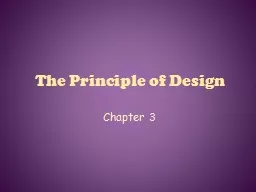

We have learned about the elements of art the atoms or building blocks now we need to learn about HOW we could use the elements In other words things to consider when putting the elements together We call these ID: 782818
Download The PPT/PDF document "The Principle of Design Chapter 3" is the property of its rightful owner. Permission is granted to download and print the materials on this web site for personal, non-commercial use only, and to display it on your personal computer provided you do not modify the materials and that you retain all copyright notices contained in the materials. By downloading content from our website, you accept the terms of this agreement.
Slide1
The Principle of Design
Chapter 3
Slide2We have learned about the “elements” of art (the “atoms” or “building blocks”) now we need to learn about HOW we could use the “elements”. In other words, “things to consider” when putting the elements together! We call these
THE PRINCIPLES OF DESIGN
Slide3The first thing we will consider is
PLACEMENT
(or
composition)
Where we decide to place the shapes, lines, etc. in our art work is called the “placement” or “composition”.The arrival of the first element produces 2 shapes: the positive form (or space) and the negative form (or space). We sometime call this the “figure” and the “ground”.
What is the POSITIVE & NEGATIVE in this art work?
Slide4When looking at any art work a good question to ask is: “Why did they put that there?”
By changing the “placement” or “composition” we can change the mood or message of the art work”
How would this art change if the lines were lined up horizontally or vertically?
Slide5Slide6The next principle is
BALANCE
Balance is a natural human desire. Artists often try to achieve this by balancing
VISUAL WEIGHT
(the more something draws the eye the more visual weight it has)
Slide7Notice how this artist balanced the “visual weight”
Fur Traders Descending the Missouri by George Caleb Bingham
Slide8A couple of things more about balance:
This is an example of
symmetrical balance
(if you fold in half the 2 sides basically match).
Slide9This is an example of
radial balance
(elements revolve around a central point).
This is a mandalas
which Buddhist use for mediation.https://www.youtube.com/watch?v=IYVcjFhpsHc
Slide10The next principle to consider is
EMPHASIS
If everything in an art work gets equal attention it becomes overwhelming and confusing so artists create “emphasis” to help the viewer see what they want them to see.
How do I create emphasis?
Slide11So, how do artists create emphasis There are lots of ways, here are a few:
Focus & Detail
Slide12LEADING LINES OR SHAPES
UNUSUAL COLOR, TEXTURE, SHAPE, ETC.
Slide13How did this artist add EMPHASIS
Slide14The next principle is
UNITY AND VARIETY
Art works need something to unify them but too much unity gets boring so we also need variety. How does artist Tara Donovan get both unity and variety in her art work?
Untitled, 2003
by Tara Donovan
Slide15B.
Slide16Here is some more art by Tara Donavan:
https://www.youtube.com/watch?v=lSCSnKqBNHg
Slide17Rhythm
is one way to create Unity. It is
created by repeating elements. What elements to you see repeated in this art work?
Two Calla Lilies on Pink by Georgia O’Keefe
Slide18Here is a little bit more about Georgia O’Keeffe:
https://www.youtube.com/watch?v=v71awD38Qy4
Slide19The next Principle of Design is
PROPORTION AND SCALE
.
Proportion compares the parts of one thing to each other. Scale has to do with something and a “constant. How does Giacometti play with
proportion?
Walking Man by Alberto Giacometti
Slide20This artist had some fun with scale!
Under the Table by Robert
Therrien
Slide21Why do you think this artist changed the scale of the child’s head?
Echo of a Scream by David
Siquieros
Slide22Lastly, artists must also consider what
PERSPECTIVE
(organizing space and depth) they will use.
How do artists create a sense of space or PERSPECTIVE???
Slide23This artist used
atmospheric perspective
(things get lighter and bluer in the distance).
Slide24This artist used overlapping to give the sense of depth.
Maple Leaves at the
Tekona
Shrine
by
Utagawa Hiroshige
Slide25This artist used
linear perspective
or (
one-point perspective).
Notice how all the horizontal lines resend to one-point.
Slide26This is the
horizon line
.
This is the
vanishing point
.
Slide27Cubism
found a new way to organize space. In this art work,
Violin and Palette
by Georges Braque
, the artist ignores traditional methods of showing depth.
Slide28This artist also played with perspective.
Waterfall
by
M.C.Escher